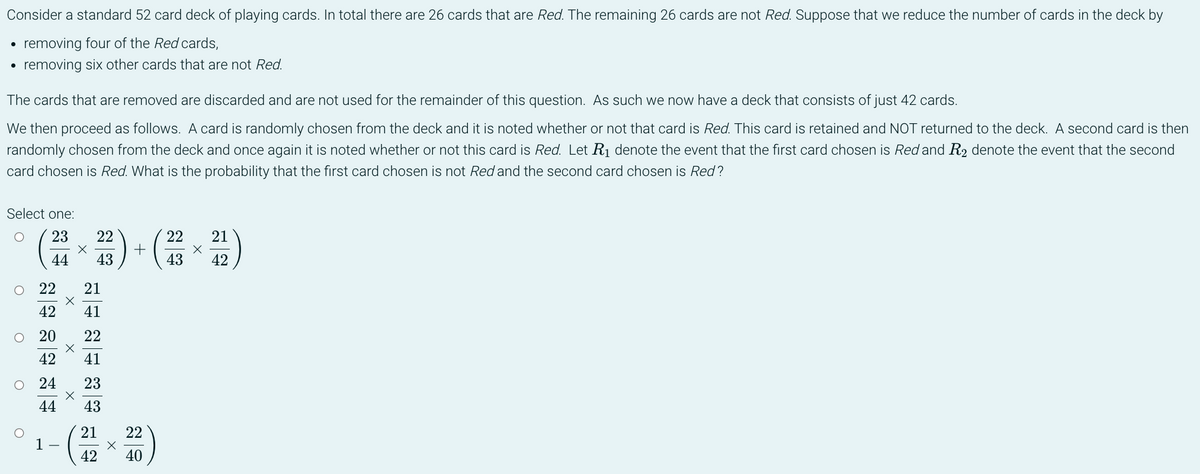Consider a standard 52 card deck of playing cards. In total there are 26 cards that are Red. The remaining 26 cards are not Red. Suppose that we reduce the number of cards in the deck by • removing four of the Red cards, • removing six other cards that are not Red. The cards that are removed are discarded and are not used for the remainder of this question. As such we now have a deck that consists of just 42 cards. We then proceed as follows. A card is randomly chosen from the deck and it is noted whether or not that card is Red. This card is retained and NOT returned to the deck. A second card is then randomly chosen from the deck and once again it is noted whether or not this card is Red. Let R₁ denote the event that the first card chosen is Red and R₂ denote the event that the second card chosen is Red. What is the probability that the first card chosen is not Red and the second card chosen is Red? Select one: O 23 22 22 21 44 43 42 O O 21 41 20 22 42 41 24 23 X 44 43 1- X X x + 22 x 42 40 X
Consider a standard 52 card deck of playing cards. In total there are 26 cards that are Red. The remaining 26 cards are not Red. Suppose that we reduce the number of cards in the deck by • removing four of the Red cards, • removing six other cards that are not Red. The cards that are removed are discarded and are not used for the remainder of this question. As such we now have a deck that consists of just 42 cards. We then proceed as follows. A card is randomly chosen from the deck and it is noted whether or not that card is Red. This card is retained and NOT returned to the deck. A second card is then randomly chosen from the deck and once again it is noted whether or not this card is Red. Let R₁ denote the event that the first card chosen is Red and R₂ denote the event that the second card chosen is Red. What is the probability that the first card chosen is not Red and the second card chosen is Red? Select one: O 23 22 22 21 44 43 42 O O 21 41 20 22 42 41 24 23 X 44 43 1- X X x + 22 x 42 40 X
Algebra and Trigonometry (MindTap Course List)
4th Edition
ISBN:9781305071742
Author:James Stewart, Lothar Redlin, Saleem Watson
Publisher:James Stewart, Lothar Redlin, Saleem Watson
Chapter14: Counting And Probability
Section14.CT: Chapter Test
Problem 3CT: An Internet service provider requires its customer to select a password consisting of four letters...
Related questions
Question
q14-

Transcribed Image Text:Consider a standard 52 card deck of playing cards. In total there are 26 cards that are Red. The remaining 26 cards are not Red. Suppose that we reduce the number of cards in the deck by
removing four of the Red cards,
●
removing six other cards that are not Red.
The cards that are removed are discarded and are not used for the remainder of this question. As such we now have a deck that consists of just 42 cards.
We then proceed as follows. A card is randomly chosen from the deck and it is noted whether or not that card is Red. This card is retained and NOT returned to the deck. A second card is then
randomly chosen from the deck and once again it is noted whether or not this card is Red. Let R₁ denote the event that the first card chosen is Red and R₂ denote the event that the second
card chosen is Red. What is the probability that the first card chosen is not Red and the second card chosen is Red?
Select one:
23
22
X
22 × 212)
44 43
43
42
O 22
21
42
41
O 20
22
41
42
O 24
23
44
43
21 22
1-
X
42
40
X
X
X
+
Expert Solution
This question has been solved!
Explore an expertly crafted, step-by-step solution for a thorough understanding of key concepts.
Step by step
Solved in 2 steps with 2 images

Recommended textbooks for you

Algebra and Trigonometry (MindTap Course List)
Algebra
ISBN:
9781305071742
Author:
James Stewart, Lothar Redlin, Saleem Watson
Publisher:
Cengage Learning

Algebra and Trigonometry (MindTap Course List)
Algebra
ISBN:
9781305071742
Author:
James Stewart, Lothar Redlin, Saleem Watson
Publisher:
Cengage Learning